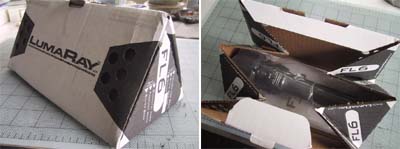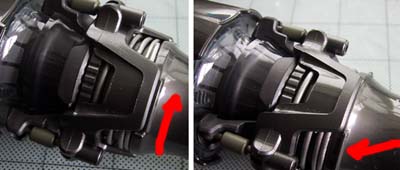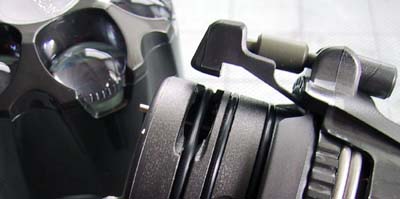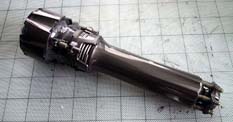
| Today |
| Carolyn's World |
| Gear & Gadgets |
| Garage |
| Garden |
| Kitchen |
| Unaccompanied Minors |
| Workshops |
| Contact Us |
| Index |
Gear & Gadgets...
|
||
We knew something was different about this product when the UPS guy dropped it off in our office. The package was triangular. We don't get many triangular packages. It opened to reveal what we at first thought was a Jedi Light Saber. You know, Ray... Luma, a logical assumption. However, it turned out to be a flashlight. Not just any flashlight, it looked like a flashlight from the future.
The LumaRay FL6 came in a cleverly designed shipping box. The shape gave maximum protection with minimal packaging. We loved what we thought were little air holes on the sides of the box. We later reconsidered and decided the holes were there to make the package easier to grasp. Either way, they showed that no details were too small for those LumaRay engineers :-) We are not much on reading instruction manuals... so when we took the FL6 out of the box, we took on the challenge of figuring out how to take the unit apart so we can put in the batteries.
After a few false starts, we finally figured out the purpose to all the different twisting and turning parts. The photo on the left shows the clamp in the "blocked" position and cannot slide down. By holding the head and turning the handle, the slide for the clamping mechanism need to be in the position indicated by the right red arrow. Now the slide can be freely moved down... unclamping the head unit. Sure it might have been easier to read the manual, but what fun was there in that?
Once unclamped, we dropped in 3 C batteries. We noticed the batteries did not "plop" into the barrel like they do with our other flashlights. Hmmm... interesting.
Upon closer inspection, we realized one of the three rubber o-rings (blue arrows) functioned as the "anti-plopping" guide. It also kept the batteries from flying out when you tilt the barrel down... quite a nice little touch! We reassembled everything. A twist of the LED head turned on the FL6. The beam struck and immediately blinded our intern for about 30 seconds. This thing is BRIGHT!
We turned the light off so our intern can feel her way to a chair. That's when we noticed a green "glow" from the lens. Hmmm... that's kind of strange. Well, we decided to consult the manual on this one. Apparently, that was the "glow element" glowing. The "glow element" gets charged each time the light is turned on. Its purpose was to make the FL6 easier to locate in the dark... COOL! We also noticed the light was a lot bluer than those from a incandescent light. The photo below show the light from the FL6 on the left and the SureFire E2E on the right.
Even though the light is bright, it takes a lot less power to run LED bulbs compared to incandescent ones. The FL6 was stated to work continuously for about 200 hours on the 3 C batteries. The FL6 is supposed to be waterproofed to 15 feet... we did not have a chance to test this feature yet. Come back in a few months when we post our "in the wild" update and we'll let you know how well it worked.
|
LumaRay FL6 |
|
LumaRay wanted to completely rethink the common flashlight. What they came up with was anything but common!
Besides having a radically different look, the FL6 has: Six super bright LED, a polycarbonate Xenoy body, and is waterproof up to 15 feet. Come back in a few months and check out the review again to see how the FL6 held up "In The Wild"! Review Summary: Initial Impression- Way Out There Usability- Very Simple Durability- Test in progress Price- about $70
Related Reviews: 1. LumaRay FL12 2. SureFire
|
||







